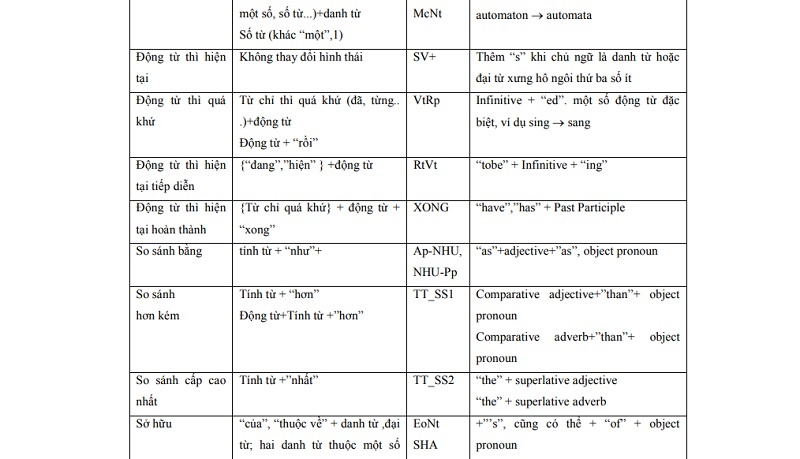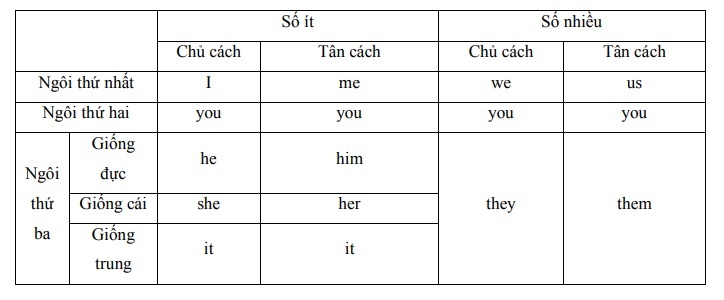4.2. Language difference between Vietnamese and English
There are many differences in word morphology between Vietnamese and English languages. However, not all differences can be handled in machine translation. With the associative grammar model, it is possible to construct a machine-readable rule set quite simply to overcome most of these differences. Before going into details, the thesis reviews the basic differences between the two languages Vietnamese – English.

4.2.1. Morphological difference
Although there are many similarities with English such as following the same SVO sentence order, the difference between Vietnamese and English is huge. According to Stankevich’s classification of languages mentioned in [21], Vietnamese is classified as an analytic (single) language or a non-morphological type with the following characteristics: in language activities, words are not Morphological change, grammatical meaning lies outside the word (according to Dinh Dien [4]). English is a synthetic language with morphological changes, although the rules of morphological change are not as strict as Russian or French. Table 4.1. The following shows the major morphological differences between Vietnamese and English.
Table 4.1. Important morphological differences between Vietnamese and English
| Tissue description | Special points in Vietnamese sentences | End connect | Need change in English |
| Plural noun | From the plural (many, a few, a number, number of words…) + noun Number of words (other than “one”, 1) | DpNt McNt | +”s”, some special words, example automaton → automata |
| Present tense verbs | Do not change the image thai | SV+ | Add “s” when the subject is a third person singular noun or pronoun |
| Past tense verbs | Past tense (already, ever…)+verb Verb + “already” | VtRp | Infinitive + “ed”. one number of special verbs, for example sing → to |
| Present tense verbs continue | {“is”,”shows” } +active are from | RtVt | “tobe” + Infinitive + “ing” |
| Present tense verbs complete | {past word} + verb word + “done” | ACCOMPLISHED | “have”,”has” + Past Participle |
| Compare with | adjective + “like” + | Ap-NHU, NHU-Pp | “as”+adjective+”as”, object pronoun |
| Compare more or less | Adjective + “more” Verb+Adjective +”more” | TT_SS1 | Comparative adjective+”than”+ object pronoun Comparative adverb+”than”+ object pronoun |
| Top level comparison | Adjective + “most” | TT_SS2 | “the” + superlative adjective “the” + superlative adverb |
| Own | “of”, “belongs to” + noun, pronoun; two nouns of some kind go together | EoNt SHA | +”‘s”, can also + “of” + object pronoun Possessive adjective,possessive pronoun, noun in possessive form |
| Noun for material | “equal”,”word” + noun only material Noun + noun of substance Whether | ONLY NtEm | Change to adjective corresponding (rock→rocky) |
| Adjective as predicate | SA | Verb “to be”+ adjective | |
| Adjectives, standing verbs after “the”,”the” | Wisdom, work construct | SU | Mark delete words This is in English translation |
| Noun of type | Accompanied by specific nouns | McNc-& NcNt+ | Delete these words if the number other accompanying words “one”,”1” Opposite translates to English words “the”, “a” |
Maybe you are interested!
-
 Vietnamese linking grammar model - 21
Vietnamese linking grammar model - 21 -
 Vietnamese linking grammar model - 22
Vietnamese linking grammar model - 22 -
 Development Situation Of Machine Translation In Vietnam
Development Situation Of Machine Translation In Vietnam -
 The Machine Translation System Uses Annotated Selections
The Machine Translation System Uses Annotated Selections -
 Vietnamese linking grammar model - 26
Vietnamese linking grammar model - 26 -
 Test Results With Annotated Selection-Based Translator
Test Results With Annotated Selection-Based Translator
In addition to the above morphological differences, there are also differences in some special words. These differences require handling in the Vietnamese-English translation process
Address pronouns
The use of pronouns in Vietnamese is very complicated. Translating into another language requires many rules to cover all cases. Table 4.2. Below is a list of English pronouns that are used in different cases
Table 4.2. English pronouns

It can be seen that the number of pronouns in English is quite small, closely related to the grammatical structure. Vietnamese pronouns and phrases that function as pronouns are listed in Table 4.3.
Table 4.3. Vietnamese pronouns
![The above table is summarized according to [1], [2], [8], [28]. Due to the richness of the 3](uploads/2021/08/19/luan-an-tien-si-cntt-mo-hinh-van-pham-lien-ket-tieng-viet-24-2.jpg)
The above table is summarized according to [1], [2], [8], [28]. Due to the richness of the Vietnamese language, an English pronoun can correspond to quite a few Vietnamese pronouns, for example the English pronoun “they” can be a translation of “he”. “them”, “them”, “them”, “them”, “them”, “them”. Not all of these words appear in the Vietnamese dictionary as separate entries. In most dictionaries there are no words “she”, “you”, understood as phrases.
Verb “to go”
In Vietnamese, the verb go can be used with other verbs such as “going to school”, “going out”, “going to swim”… When translated into English, most verbs after the verb “go” can be used with other verbs. replaced with gerunds, for example: “go swimming” – “go swimming”, “go shopping” – “go shopping”… however there are exceptions like “go to school” – “go to school”, “go out” – “go out”.
4.2.2. Differences in word order
Vietnamese and English mainly have the following differences in word order:
Order in noun phrase – adjective
In English, adjectives always come before nouns while in Vietnamese, nouns come before adjectives (except for some exceptions like in the phrase “poor resources” with AN connection). Here is an image illustrating the rearrangement of word order:

Figure 4.1.Rearrange word order
When translating the sentence “I buy the red wallet”, the result should be “I buy the red wallet”. In the result, the word “red” (adjective) comes before “wallet” (noun). This is the result that the word “wallet” at position 4 in the source sentence has been mapped to the word “wallet” at position 5 in the target sentence, while the word “red” is at position 5 in the target sentence. source is mapped to the word “red” in position 4 in the target sentence. The order of two and three adjectives after the noun is also changed in the same way.
Order of interrogative, interrogative – negative sentences:
The most commonly used question form in Vietnamese involves the word (phrase) to ask, for example “why”, “who”, “how”. These words are usually at the beginning or end of a sentence. In the English “wh” question form, the question word always comes first. Therefore, it is necessary to change the word order, as well as add the appropriate auxiliary verb ….
Non-neighborhood word order
Non-neighborhood word order is a dependency established between words that are a certain distance apart. This type of dependency can be caused by a “gap” caused by a change in the position of a word, for example, “The wedding gift for the bride, I sent it”, or in compound and complex sentences. with statements such as “The shirt I bought yesterday is very beautiful”. When translating into English, to ensure the meaning of a sentence, it is often necessary to change the position of the word, but the position change for this type of sentence is difficult to represent simply by translation rules. Analyzing and translating this type of sentence requires statistical methods, machine learning with large datasets that we have not had the conditions to build.






